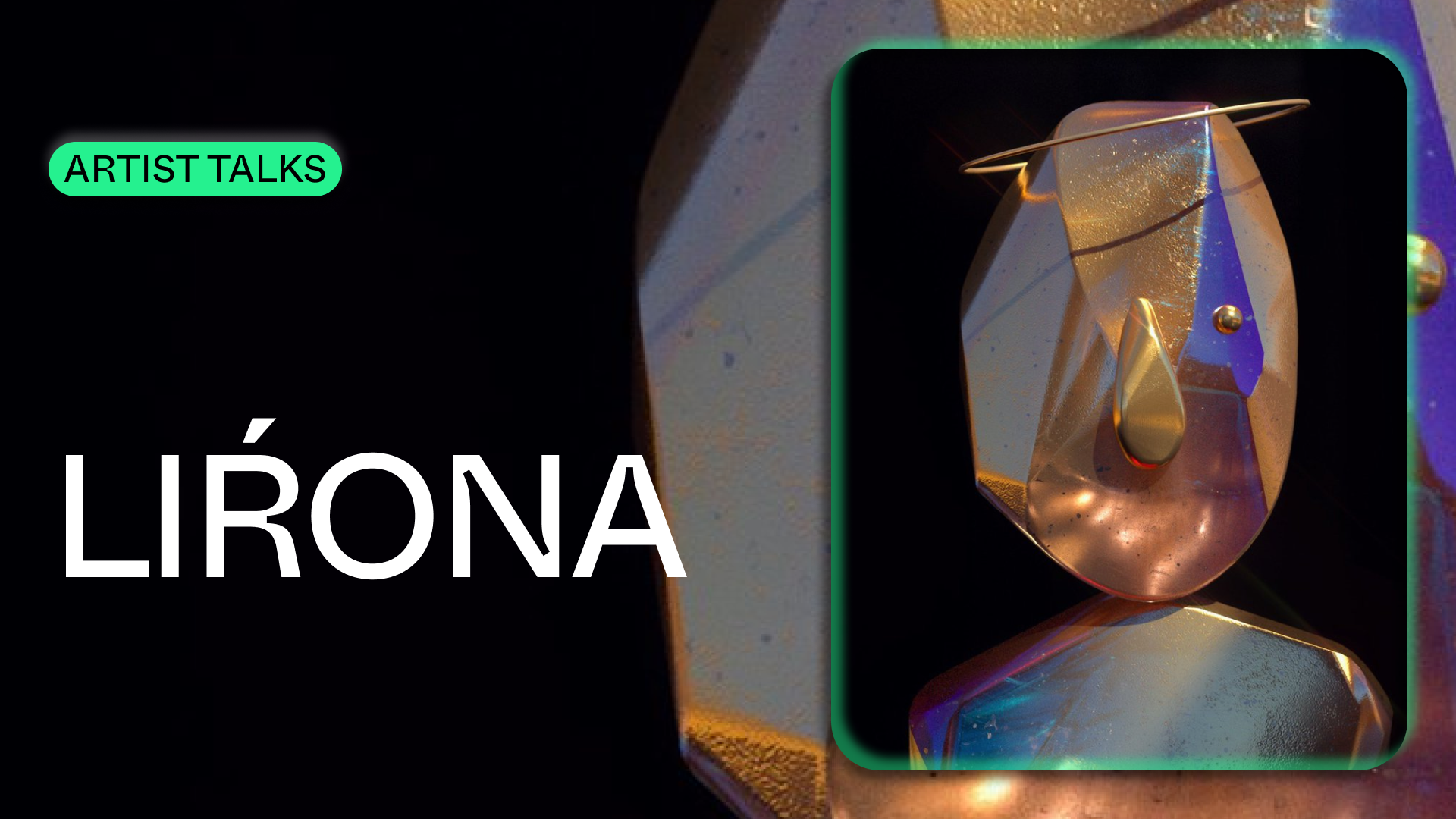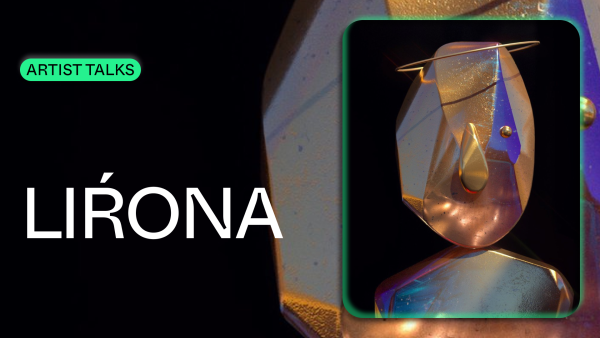Artist Talks: LIŔONA On How PFPs Changed The Art World.


In this edition of Artist Talks, Palm NFT Studio welcomes LIŔONA (Liron Eldar-Ashkenazi), an award-winning NY/LA-based Design Director, Illustrator & Artist. LIŔONA is currently Associate Creative Director at BUCK, where she helped create the visual brand identity for Palm NFT Studio, while also developing the branding system for the Palm network—a fast, efficient, and eco-friendly blockchain technology.
Can you describe yourself, what you do, and your work?
“That’s a good question; a tough one. I’m many things. I’m first and foremost a problem solver, designer, and thinker who thrives on learning new ways of solving visual problems for myself, and my clients. Then, I’m an artist, an experimental hands-on excecutionist who loves exploring all sorts of digital mediums (2D illustration, 3D, VR, animation, code). Then, (I hope) I’m a mentor, feeling an ever-growing need to push others in those spaces to pursue their dreams and develop their craft, critically think about our industry, and experiment. Lastly, I’m a student, knowing there’s so much out there to learn, by myself, or with the help of others (Friends, Family, Mentors, or just inspirations).”
LIŔONA started their career at the esteemed design studio Sagmeister&Walsh, later, led a small design studio at The-Artery, Associate Creative Director at BUCK. After graduating from The School of Visual Arts (SVA), she was selected as one of PRINT Magazine’s ’15 Under 30′ most promising designers working in the industry. Her style is usually described as bold, contemporary & daring, as well as heavily dependent on strategy, beauty & high-end craft.
When did you first start as an artist or designer?
“At the age of 14 when I started writing a blog, designing with CSS on myspace, and stealing my parents’ digital camera to shoot portraits and editing them on Paintshop Pro (haha, oh, the early 2000s were a vibe). Later, as a motion graphics artist in the army, I learned every software could be learned with a dedicated time to learn it, but design, well, design is something you need a professor to teach you…so I set a goal to study at the best design school in the United States, the School of Visual Arts in New York.
How did your experiences at Sagmeister & Walsh and the School of Visual Arts inspire your design process?
“It made me whole as a creative. If before that time I knew I had a seed of visual expressions, after those experiences I understood that I can transform them into a career I not only enjoy but can actually make a good living from. Learning from the teachers and mentors at SVA, and later, being mentored by Jessica (Walsh) outside of school, and into the first year of my career is priceless, it’s something I feel moved by on a daily basis, how fortunate I was to have that early on. After graduation and while working at Sagmeister & Walsh, I finally felt like a designer. As for Artist, well, that took a long time until I finally felt like something I consider myself. I’m still battling with that term from time to time. What is Art, what constitutes as Artist (with a capital A).”
Did your environment have any effect on your decision to engage in art?
“I grew up with undiagnosed ADD (attention deficit disorder) and didn’t do very well in school. I was one of those kids that the teachers always said has “potential” but can’t seem to fulfill it. When a kid has ADD, and not ADHD (Omitting ‘hyperactivity’) it’s very hard to diagnose, especially in the early 2000s. It made me think that I just wasn’t good enough; that I couldn’t work hard enough like the other kids and didn’t care enough about my future. My parents were very supportive of what I was good at, sports and artistic pursuits, which I never took for granted. When I grew up, I realized it wasn’t that I didn’t want, it’s that I couldn’t – but following my heart and gut into art and design proves that as long as you do what you love, you can fight biology and succeed anyways, on your own terms. So yes, the environment of “can-do” I grew up in certainly contributed to who I am today and why I do what I do. I have a lot of people to thank for that.”
What is Buck? How did you come about working with them?
“BUCK is an incredible creative studio. Our size is actually that of a large agency, but the feeling is still of a small dedicated studio run by wild creative minds. We currently have offices in New York, Los Angeles, Amsterdam, and Sydney.
BUCK was always known for its exceptional animation and storytelling, but today we do everything from branding & game design to shooting live-action and experiential work; really dabbling in every creative pursuit, commercial and non-commercial. I started working here as a freelancer in the Brooklyn offices at the beginning of 2020, right before the pandemic, then quickly came in full-time after falling in love with the people, the management, and the work. When the pandemic hit, we all transitioned to working from home, and my husband and I moved to California. Since the Pandemic, BUCK has taken a more global approach, and hired artists from all over the world. Today I work remotely out of LA. It’s been my dream to work there since I’ve seen their work in art school.”
How do you balance your artistry and your design work for clients?
“It’s simple. I don’t need to ‘balance’ it, I get to bring my artistry into my client work on a daily basis. So, continuing this on my free time (nights, weekends, time-off, etc.) is actually really easy and flows well. I think it’s also a bit because BUCK really does reward and push for high-end art even in our commercial work.
#BOIZ: a series of uniquely sculpted collectible avatars created by LIŔONA.
Is the presence of NFTs a game-changer for an artist like yourself or your peers?
“Totally. I never thought that anything would push me to think of design and branding the way that my #boiz project has.”
The #BOIZ are a series of uniquely sculpted collectible avatars. The original #boi was dreamed in VR by #mother, aka LIŔONA. Boiz was the first 3D-based NFT PFP project and started a movement towards many other successful collections. Each Boi represents unique archetypes of genderless creatures in the metaverse. There will only ever be 100 unique designs and 1000 editions.
LIŔONA: “Really coming up with ideas, crafting and sharpening them over a period of time, building a brand, a tone of voice, a marketing strategy, and a roadmap — all-around art. I believe there’s something incredibly empowering about it. Financially, it’s amazing to make an incredible living out of the most artistic-raw work you produce, but it’s more about validation than it is about capital. It’s knowing people truly care about my work and the details I put into it.”
You’re one of (or THE) main inspirations for 3D PFP NFT projects. What was your thought process when creating the mechanics of the BOIZ collection?
“A lot of that thinking I’ve done with my incredible husband and best friend, Gal Eldar. When I started out with the project, Gal was the one who looked at the first #boi sculpture I made and told me how well it will work as a profile picture. He was also the one who turned me towards NFTs in general in mid-2020. The inspiration for the collection came out of seeing CryptoPunks and Hashmasks; Gal sent those to me and we sat looking at them for hours, decrypting what about them made the project so successful and iconic…and what about them could be developed and improved. Lastly, [I thought what about] my work and my style can come to life in this specific, collectible way. The rest is history, I dropped the first 8 #boiz on Rarible on February 2021, gifting my “first-born” Genesis #boi to Fvckrender as a “Thank You” for all his support and advice (which I’m still so thankful for until this day) and the others were quickly snagged by JSTN and GreekTycoon. The entire collection was sold-out quickly. At that time I was practically a nobody on Twitter and that’s when we knew we had something. Deciding on 100 #boiz designs and 1000 #boiz including editions is an important decision I made early on. Making sure the project wouldn’t become never-ending was important. I wanted to make sure that at some point I would finish it and move into other creative directions, keep my craft fresh, and continue keeping my collectors excited and engaged.”
What was your role in the formation of Palm NFT Studio’s visual identity?
“Palm is one of my favorite projects I’ve led at BUCK this year, alongside incredible artists and designers. I was the Lead Associate Creative Director on the project and a hands-on art director. I worked with a small and dedicated team of graphic designers and strategists to come up with solutions to the brief Palm had for us under the supervision of Camille Chu.”
One of our favorite phrases we’ve heard you mention to describe your work for Palm NFT Studio’s visual design was “Organic-Digital as a theme.” Could you describe that?
“We targeted an aesthetic that could flex to a variety of themes, chief among them organic-digital; but also growth, transformation, and balance. We crafted a tech jungle — a unique array of generated shapes that systematically create an eclectic yet refined design language. The idea of Organic Digital is that “digital” doesn’t have to be cold and sterile — or “put together”. There’s a wildness in this computer-generated ‘fabric’ that is all built with math but incorporates a deep emotion, a sense of physicality, and space. We grounded the whole aesthetic while still building a flexing system.”
There’s such a generative approach to Palm Networks’s visual system as well. Can you elaborate on “Digital Fabric” as a concept?
“The visual system features various containers, with each mark using a similar underlying textured fill that we fondly dubbed The Digital Fabric.
By feeding our program a set of images and extracting color, tone, and other values, we concocted a system capable of generating infinite static or dynamic visuals. Employing this generative visual approach helps create a more inclusive and varied experience across brand touchpoints. This textural, warm, and noisy pattern is the glue that connects the organic, yet very sharp containers and the flow of emotional colorful visual information to create the overall theme: Organic-digital.”
In her free time, LIŔONA likes crafting digital art, advising companies, and leading projects on their brands and social media presence. Learn more about their work here.
Experience more LIŔONA on:







